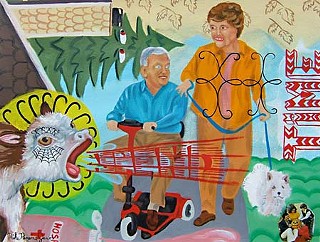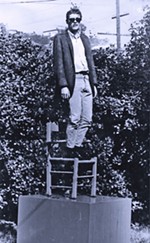Welcome Home
This group show leaves one feeling that hokey notions of home still haunt us
Reviewed by Robert Faires, Fri., Oct. 24, 2008
'Welcome Home'
Gallery Lombardi
Through Nov. 1
From the days of Odysseus to Dorothy, home was the place that you would do anything to get back to. Lately, though, it seems more like the place you'd do anything to get away from.
Maybe it's the cookie-cutter oppressiveness of midcentury suburbia or fallout from the explosion of the nuclear family, but home ain't what it used to be. There's an unease that's crept into our sense of the place, a feeling that it represents repression and unmet expectations and false cheer. Home is broken or, if not that, then stuck in a past that's long faded away; it's a dead zone.
The first images you pass in the group exhibit "Welcome Home" hint at as much: four paintings by Mike Parsons, who curated the show, each showing part of a home over which is superimposed the face of a woman whose appearance suggests the 1950s or 1960s. They could easily be a kitschy tip of the fedora to the pioneers of suburbia, but the transparency of the faces suggests that these women are no longer with us. And if they're gone, what happened to those houses they lived in? Has home vanished, too?
There's a definite sense of a lost past in Andy Rihn's remarkable installation, Manville. On one side, the work is a tall wall of weathered wood suggesting an old shack with a bucket by the door overflowing with empty Schlitz cans. On the opposite side is a haven for a grandfather from another age. Lining the wall, floor to ceiling, are tools. An easy chair with vinyl the color of nicotine-stained fingers has an ashtray filled with cigarette butts on its arm and the residue of a TV-tray snack beside it. Under a desk is a stack of early-Sixties Playboys. The air is as thick with the scent of testosterone as with the odor of rusty metal and burned tobacco, and if you had a grandpa who had or wished he had a hideaway like this, as I did, it's heavy with nostalgia, too. You might not want everything this "home" stands for to hold sway the way it once did – the heavy smoking, heavy drinking, macho-shithead 'tude – but it's hard not to miss the strength that lived there, the love of working with one's hands, the plain talk, the rough edges.
A like ambivalence suffuses Parsons' large paintings next to Manville. Each work is packed with visual elements: a setting in a traditional-looking neighborhood – children playing as a man mows his lawn, a family meal outdoors, people young and old out for a stroll – but crowding in on them are animals, design patterns, text, and textures that feel dense with symbolism. The human figures have a stock quality, like they're lifted from ads or old sitcoms that tried to sell us the perfect home and town: Andy's Mayberry, Beaver's Mayfield. At first, you might suspect Parsons of mocking those manufactured ideals of home, and maybe he is, but many of the elements – the kids, the creatures, the human connections being made, the positive titles – can also be read as sincere, as if this dated, even laughable concept of "home" still has some hold on us. We yearn for the good things it gave us.
What's left of home? Is it, as the labeled pillows on Chrissy Paszalek's Bed Installation suggest, where our fears take up as much space as our hopes? Her other pieces here, a fabric hand reaching under a door and a photograph of a man seeming to peek in at a window, certainly address a modern sense of anxiety, a concern that no place is safe.
Not everything speaks as overtly of home – Parsons' large prints of childhood characters that look like rejected Muppets; Dennis Hodges' fun oils on panels starring anthropomorphic critters looking effed-up and his birdhouse built around a glass jug with a dazed cartoon head painted on it; Candace Briceño's lovely cloth panel hand-dyed a sensuous green with leaf shapes cut from it – but the works that do are the heart of the show. They leave you wondering if we haven't outgrown those hokey values from neighborhoods gone by. As you leave, you have to pass by Parsons' ghostly women again, and it feels like if they're not haunting us, surely their homes are.











